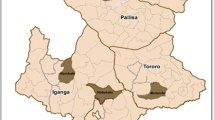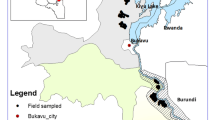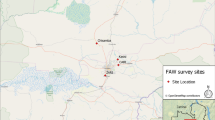Abstract
The Fall armyworm (FAW), Spodoptera frugiperda, was first reported in a few regions of Burkina Faso in 2017. Since then, it has continued to spread and damage maize crops in the country, thereby threatening food security. This study, conducted three years later, aimed to assess the pest status on major rainy season crops, and the effects of cropping systems, crop diversity, and phenology in 11 localities of Sudanian and Sudano-Sahelian zones in Burkina Faso. Two sampling periods, the first conducted at the beginning of the rainy season and the second at the end of the season, were considered. Maize was the most FAW-infested crop, mainly as monocrops (84–88% of surveyed fields). Sorghum, pearl millet, cowpeas, and peanuts were the secondary infested crops, more infested when intercropped with maize. Maize fields were more FAW-affected in the Sudanian zone, whereas the secondary infested crops were significantly more affected in the Sudano-Sahelian zone. The highest field infestation rates were recorded during the second survey period, coinciding in most cases (> 90%) with the flowering and post-flowering of maize. Then, FAW attacks were found in vegetative, flowering, and post-flowering cereal organs. Despite the technical recommendations, most farmers (57.30 ± 10.34 and 66.78 ± 6.74% in the Sudanian and Sudano-Sahelian zones, respectively) did not apply insecticide in infested maize fields. Thus, in 3 years, the FAW has become an important pest of cereals, specifically maize, in the main agricultural zones of Burkina Faso. These results should be taken into account to develop effective control actions against FAW.





Similar content being viewed by others
Data availability
The data and material of this manuscript are available from the corresponding author’s institution on reasonable request.
References
Babu RS, Kalyan RK, Joshi S, Balai CM, Mahla MK, Rokadia P (2019) Report of an exotic invasive pest the fall armyworm, Spodoptera frugiperda (J. E. Smith) on maize in Southern Rajasthan. J Entomol Zool Stud 7(3):1296–1300
Bateman ML, Day RK, Luke B, Edgington S, Kuhlmann U, Cock MJ (2018) Assessment of potential biopesticide options for managing fall armyworm (Spodoptera frugiperda) in Africa. J Appl Entomol 142(9):805–819
Baudron F, Allah MAZ, Chaipa I, Chari N, Chinwada P (2019) Understanding the factors influencing Fall Army Worm (Spodoptera frugiperda) damage in African small holder maize fields and quantifying its impact on yield. Crop Prot 120:141–150
Bhagat GS, Kushwah HS, Panwar P, Mehra R, Nagar M, Sanodiya RK, Pancheshwar DK, Rana GK (2022) Effect of intercropping mungbean, cowpea and sesame with maize and on FAW (Spodoptera frugiperda) infestation. Biol Forum 14(2):184–186
Bizimana E, Ntakirutimana L, Nimenya N, Gahimbare ML (2023) Effects of population growth on the availability of agricultural products in Burundi. Am J Econ 13(1):25–33
CABI (2018) Invasive species compendium. URL: www.cabi.org/isc/fallarmyworm [accessed 2023 March 19]
Capinera, JL (2001) Order Lepidoptera- Caterpillars, moths and butterflies. In: handbook of Vegetable Pests (pp 353–510). Academic Press
Cock MJW, Beseh PK, Buddie AG, Cafá G, Crozier J (2017) Molecular methods to detect Spodoptera frugiperda in Ghana, and implications for monitoring the spread of invasive species in developing countries. Sci Rep 7(1):1–10
Dao A, Sanou J, Gracen V, Danquah YE (2015) Identifying farmers’ preferences and constraints to maize production in two agro-ecological zones in Burkina Faso. Agric Food Secur 4(13):1–7
Day R, Abrahams P, Bateman M, Beale T, Clottey V, Cock M, Gomez J (2017) Fall armyworm: impacts and implications for Africa. Outlooks Pest Manag 28(5):196–201
DGESS (2021) Annuaire des statistiques agricoles 2020. Ministère de l’Agriculture et des Aménagements Hydro-Agricoles (MAAH) du Burkina Faso. 437 p https://www.agriculture.bf/upload/docs/application/pdf/2021-07/annuaire_agriculture_2020_def.pdf
Drabo E, Waongo A, Traoré F, Dabiré-Binso LC, Sanon A (2022) Effectiveness of combining bioacaricides with sprinkler irrigation to control the red spider mite, Tetranychus evansi Baker and Pritchard (Acari: Tetranychidae), in irrigated tomato crops in Burkina Faso. West Africa J Entomol Acarol Res 54:10055
Early R, Gongalez-Moreno P, Murphy S, Day R (2018) Forecasting the global extent of invasion of the cereal pest Spodoptera frugiperda, the fall armyworm. NeoBiota 40:25–50
FAO (2018) Integrated management of the fall armyworm on maize a guide for farmer field schools in Africa. URL: http://www.fao.org/faostat/en/.
FAO, AfDB (2015) Agricultural growth in West Africa: Market and policy drivers. Hollinger F & Staatz JM (eds). FAO ISBN 978-92-5-108700-8
Feldmann F, Rieckmann U, Winter S (2019) The spread of the fall armyworm Spodoptera frugiperda in Africa—What should be done next? J Plant Dis Prot 126:97–101
Goergen G, Kumar PL, Sankung SB, Togola A, Tamò M (2016) First report of outbreaks of the Fall Armyworm Spodoptera frugiperda JE Smith (Lepidoptera, Noctuidae), a new alien invasive pest in West and Central Africa. PLoS ONE 11:e0165632
Hailu G, Niassy S, Khan RZ, Nathan O, Subramanian S (2018) Maize-legume intercropping and push pull for management of fall armyworm, stemborers, and striga in Uganda. Agron J 110(6):1–10
He LM, Ge SS, Chen YC, Wu QL, Jiang YY, Wu KM (2019) The developmental threshold temperature, effective accumulated temperature and prediction model of developmental duration of fall armyworm Spodoptera frugiperda. Plant Prot 45(5):18–26
Hell K, Setamou M, Cardwell K, Schulthess F (2000) Influence of insect infestation on aflatoxin contamination of stored maize in four agroecological regions in Benin. Afr Entomol 8(2):169–177
Koffi D, Agboka K, Fening KO, Adjevi MKA, Badziklou JEA, Tchegueni M, Tchao M, Meagher RL (2022) Spodoptera frugiperda in Togo 5 years on: early impact of the invasion and future developments. Bull Entomol Res 113:21–28
Kumar NV, Yasodha P, Justin CGL (2020) Seasonal incidence of maize fall armyworm Spodoptera frugiperda (J. E. Smith) (Noctuidae; Lepidoptera) in Perambalur district of Tamil Nadu India. J Entomol Zool Stud 8(3):1–4
Lima MS, Silva PSL, Oliveira OF, Silva KMB, Freitas FCL (2010) Corn yield response to weed and fall armyworm controls. Planta Daninha 28(1):103–111
MAAH/DGPV (2018) Lutte contre la chenille légionnaire d’automne au Burkina Faso campagne agricole 2018–2019. Rapport général, Ministère de l’Agriculture et des aménagements Hydro-agricoles, Ouagadougou, Burkina Faso, 15p
Mendesil E, Tefera T, Blanco CA, Paula-Moraes SV, Huang F, Viteri DM, Hutchison WD (2023) The invasive fall armyworm, Spodoptera frugiperda, in Africa and Asia: responding to the food security challenge, with priorities for integrated pest management research. J Plant Dis Prot. https://doi.org/10.1007/s41348-023-00777-x
Montezano DG, Specht A, Sosa-Gómez DR, Roque-Specht VF, Sousa-Silva JC, Paula-Moraes SV, Peterson JA, Hunt T (2018) Host Plants of Spodoptera frugiperda (Lepidoptera: Noctuidae) in the Americas. Faculty publications, p 718
NEPAD (2013) Les agricultures africaines, transformations et perspectives.72p
Nyamutukwa S, Mvumi BM, Chinwada P (2022) Sustainable management of fall armyworm, Spodoptera frugiperda (J. E. Smith): challenges and proposed solutions from an African perspective. Int J Pest Manag. https://doi.org/10.1080/09670874.2022.2027549
Payne W, Tapsoba H, Baoua IB, Ba NM, N’Diaye M, Dabire-Binso C (2011) On-farm biological control of the pearl millet head miner: realization of 35 years of unsteady progress in Mali, Burkina Faso and Niger. Int J Agric Sustain 9:186–193
Prasanna BM, Huesing JE, Eddy R, Peschke VM (2018) La chenille légionnaire d’automne en Afrique : Un guide pour la lutte intégrée contre le ravageur, Première édition. Mexico, USAID & CIMMYT. URL: https://repository.cimmyt.org/handle/10883/19458.
Pumarifio L, Sileshi GW, Gripenberg S, Kaartiven R, Barrios E, Muchane MN, Midega C, Jonsson M (2015) Effects of agroforestry on pests, disease and weed control: a Meta analysis. Basic Appl Ecol 16(7):573–582
Sanou MR, Compaoré I, Sanon A (2023) Emergency response to the Spodoptera frugiperda invasion in Africa: What do maize producers in Burkina Faso think and do? Afr J Agric Res 19(1):101–112
Sawadogo M, Zahonogo P, Sawadogo J-PW (2022) Analyse des facteurs explicatifs de l’association des cultures au Burkina Faso. Econ Rur 2(380):87–101
Setamou M, Cardwell K, Schulthess F, Hell K (1998) Effect of insect damage to maize ears, with special reference to Mussidia nigrivenella (Lepidoptera: Pyralidae), on Aspergillus flavus (Deuteromycetes: Monoliales) infection and aflatoxin production in maize before harvest in the Republic of Benin. J Econ Entomol 91(2):433–438
Acknowledgements
The authors are grateful to the technicians of the Ministry in charge of agriculture in Burkina Faso for their contribution to the choice of sampling localities and to making necessary links with farmers. The research was financially supported by the Foreign, Commonwealth, and Development Office (FCDO), UK, the Directorate-General for International Cooperation (DGIS), Netherlands, the European Commission Directorate-General for International Cooperation and Development (DEVCO), and the Swiss Agency for Development and Cooperation (SDC) through CABI’s Action on Invasives and Plantwise Plus Programmes. CABI is an international intergovernmental organization, and we gratefully acknowledge the core financial support from our member countries and lead agencies. See https://www.cabi.org/aboutcabi/who-we-work-with/key-donors/ for details.
Funding
The research was financially supported by the Foreign, Commonwealth, and Development Office (FCDO), UK, the Directorate-General for International Cooperation (DGIS), Netherlands, the European Commission Directorate-General for International Cooperation and Development (DEVCO), and the Swiss Agency for Development and Cooperation (SDC) through CABI’s Action on Invasives and Plantwise Plus Programmes.
Author information
Authors and Affiliations
Contributions
All authors contributed to the research and to the paper writing. IC and MRS carried out the experiment and collected the data. AB, LKA, and AS designed and supervised the experiment, and statistical analysis was performed by IC. All authors read and approved the final manuscript.
Corresponding author
Ethics declarations
Conflict of interest
The authors declare that they have no competing interests.
Additional information
Publisher's Note
Springer Nature remains neutral with regard to jurisdictional claims in published maps and institutional affiliations.
Rights and permissions
Springer Nature or its licensor (e.g. a society or other partner) holds exclusive rights to this article under a publishing agreement with the author(s) or other rightsholder(s); author self-archiving of the accepted manuscript version of this article is solely governed by the terms of such publishing agreement and applicable law.
About this article
Cite this article
Compaoré, I., Sanou, M.R., Badolo, A. et al. Analysis of Fall armyworm infestations on rainy season crops under different cropping systems in two agroecological zones in Burkina Faso, West Africa. J Plant Dis Prot 130, 1207–1216 (2023). https://doi.org/10.1007/s41348-023-00800-1
Received:
Accepted:
Published:
Issue Date:
DOI: https://doi.org/10.1007/s41348-023-00800-1




